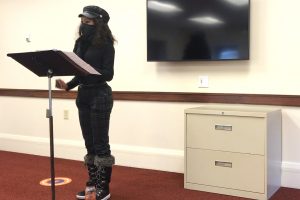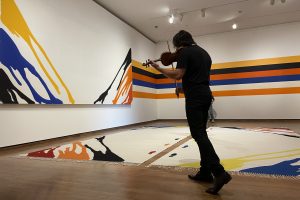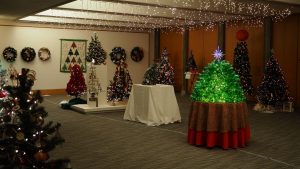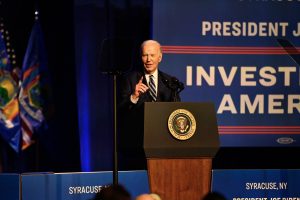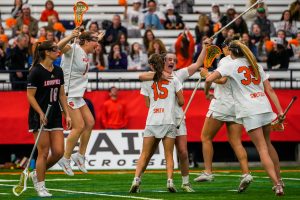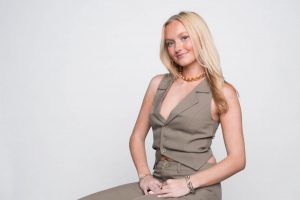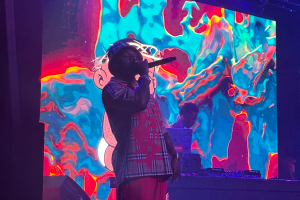Upstate NY inspires Everson’s immersive music and art experience
Upstate NY inspires Everson's curated music and art experience
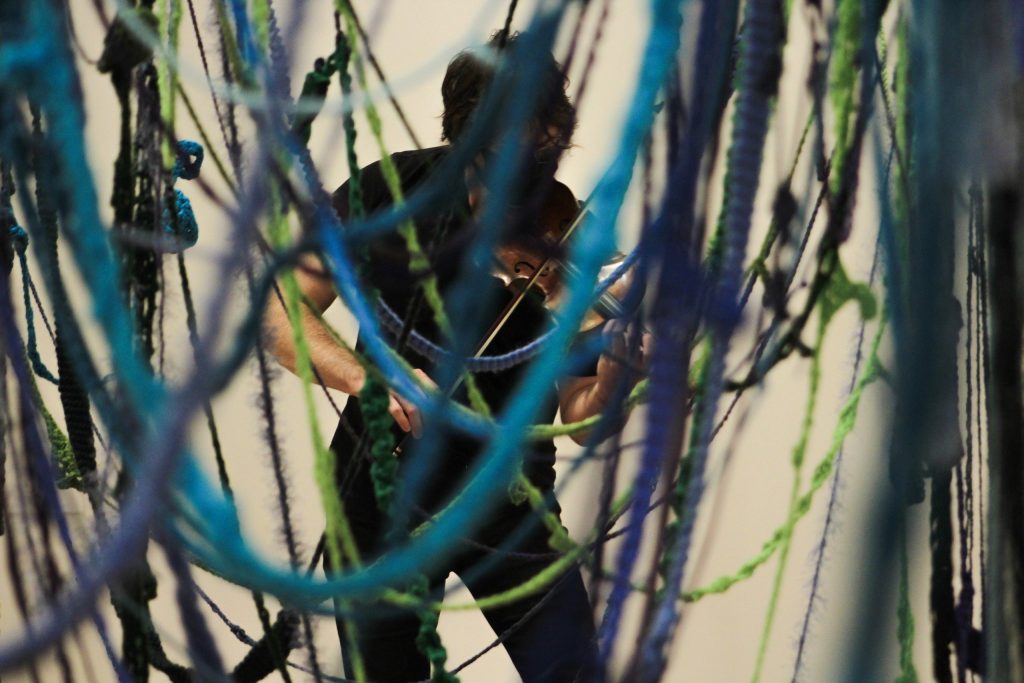
Scratches and tones float from a 300-year-old Stradivarius violin filling the galleries of the Everson Museum of Art. The sounds call to visitors, inviting them to follow the carefully composed pieces of music filling the museum. Visitors meander through the stoic galleries admiring and questioning the fibers stretched on the walls unaware the music has such strong connections to the art through structure and tone.
David Fulmer, composer, conductor, violinist, and musical curator, is a source of constant motion as he performs. Grand movements and breaths flow as unexpected sounds leave his centuries-old instrument. A snowy Christmas Eve visit to the Everson inspired Fulmer to create the concert series “Prisms and Antiphons,” commissioned to accompany the fiber works in the exhibition “AbStranded: Fiber and Abstraction in Contemporary Art.”
“Prisms and Antiphons” is an unconventional concert series consisting of four performances and features works from three emerging composers Vasiliki Krimitza, Bahar Royaee, and Alyssa Regent along with a piece by J.S. Bach. The fourth performance, and last chance to hear the works at the Everson, will be Sunday, Dec. 12, during its “Festival of Trees and Light” event with the addition of Vivaldi’s “Four Seasons.”
When he isn’t rehearsing, performing or curating concert series, Fulmer has on headphones listening to one of his many “old school” iPods. As he grew up, his draw toward the violin was always supported by his family. Lessons increased from once a week to once a day and now has had some of the best violins in the world pass through his hands including violins by the Stradivari family in the 17th and 18th centuries. Playing his first Stradivarius is an experience he will never forget.
“It was like living in one of these amazingly vivid Pixar films where everything is so vibrant in color and texture,” he said. “You feel like you have the golden ticket when you’re handed an instrument from 1694.”
As a teenager, Fulmer frequently came up from his hometown in Boston to Pulaski to enjoy the scenery of Upstate New York. Called by the beauty of the Salmon River, his days at Juilliard consisted of many fishing trips, even if he was performing in Lincoln Center that night. Despite his busy schedule touring and performing internationally, Fulmer always returns to the area.
“I have lots of commitments in Paris, London, Berlin, Oslo, and Sydney,” Fulmer said. “I would always come back, drop off one suitcase in New York City, head up north to the Syracuse area, and do all of my composing. I’m grateful for the peace and tranquility and the overall organic inspiration I get from being in Syracuse.”
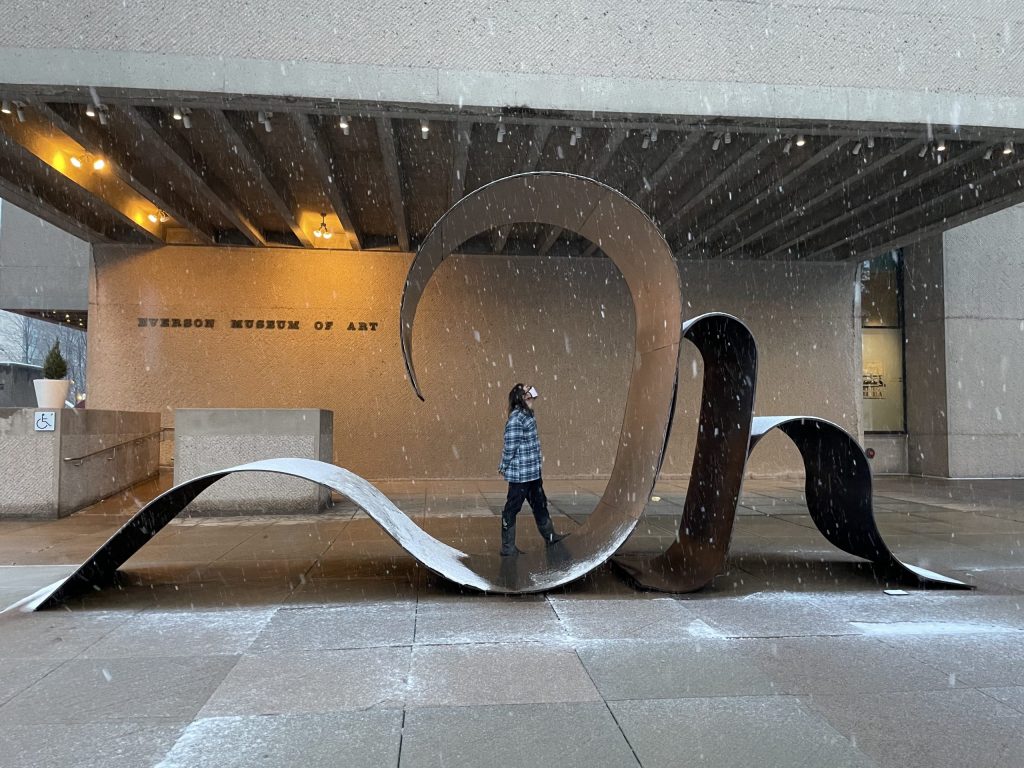
One of Fulmer’s most memorable visits to the Everson was Christmas Eve 2020 in the midst of the pandemic. Enthralled by the space designed by the notorious architect I.M. Pei, he reached out to the museum to work on something new.
“I was always aware that there was so much art going on in the city,” he said. “I had that eureka moment the day before Christmas, walking outside of the Everson and just looking at that beautiful sculpture. I said to myself, this museum is begging to be utilized as a concert space because it’s so beautiful.”
Steffi Chappell, assistant curator at the Everson, is eager about the new things happening at the museum with the concert series. Fulmer’s enthusiasm for the project spread to the others at the Everson. Chappell said although the museum has been working toward experiences that stretch across disciplines, Fulmer sped up the process immensely.
“Everyone has really loved it, from little kids to older people,” Chappell said. “It’s an amazing experience to walk into a gallery and see an installation that stretches across the entire space and listen to someone playing a musical composition that fills up the entire gallery so everything is full of both art and music. When you are able to experience that all at the same time is incredible and it’s what our visitors have commented on as something really unique.”
Walking through the gallery spaces of AbStranded, Fulmer started putting the puzzle pieces together in his mind. He said three rules were at the forefront of his thinking during the commissioning process: making sure the composers’ pieces worked with other mediums of art, they are good collaborators, and the architecture of the works fit into the overall experience of the exhibition. Fulmer took the works and connected them to the visual elements in each gallery, their structure mimicking the art throughout the exhibition.
With multiple performances of the same pieces, listeners have the opportunity to come back to the museum and experience the progressive works with a new ear. Visitors discover, listen, observe and enjoy the combination of art and music through multiple encounters.
“You can understand a lot on a first listening,” Fulmer said. “I just looked at my iPod and I’ve listened to the cavatina, which is an opus 130 string quartet, 4,128 times in the last three years. Now, that’s a piece that I know well. So imagine a piece that’s brand new, how many times it has to be heard in order for it to make sense.”
The first performance of “Prisms and Antiphons” accompanied the opening of the exhibition on Sept. 18. Starting the concert with Bach, Fulmer eased the ears of the audience with familiar classical music. Performing the Royaee as the second piece, Fulmer stood under “Bloodlines” by Anne Lindberg. The muted violin strayed far from the singing notes in the Bach.
Elisa Gutierrez, SUNY ESF student, described the experience as “eerie.”
“It made your skin crawl a few times,” Gutierrez said. “I like how we could walk around, it was fully immersive, that was really neat. Even the way he moved, it was very visual and physical.”
Each piece is highlighted in its placement in the different galleries. Fulmer described the use of Bach as a palate cleanser for the audience. The long phrases and beautiful tones sing through the space in a familiar way while the commissioned works are unfamiliar and strange with scratching noises, mutes, and different tuning on the violin.
Fulmer, being the musical curator and performer, has a close relationship with the composers and their vision for the piece while having the opportunity to add new expressions in performance.
“Yes, I am the commissioner. Yes, I am the curator, but more so I’m just the vessel of performance,” he said. “I take on the voice of the composer in order to communicate with the audience.”

